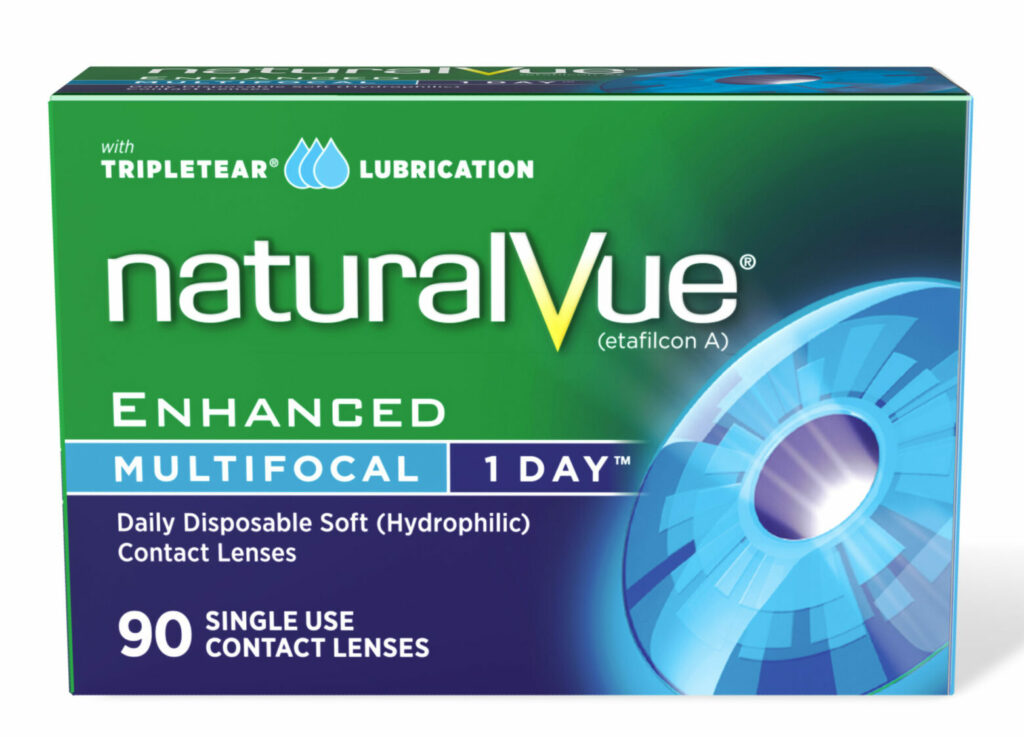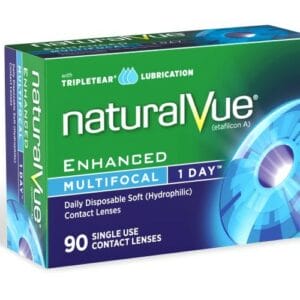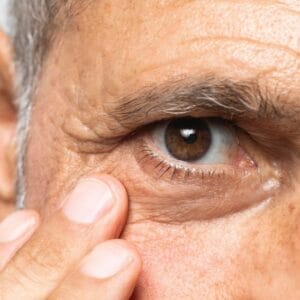sponsored content
March 28, 2024
VTI’s NaturalVue® Enhanced Multifocal 1 Day Contact Lens was designed to address the comfort issues of presbyopes, especially those 55 and older. Review of Presbyopia and the Aging Eye reached out to Dr. Andrew Brauer, OD, of Eyecare Center of DuPage in Westmont, Illinois, to get his thoughts on this multifocal lens and its specifications. In this interview with Chief Clinical Editor Dr. Jack Schaeffer, OD, FAAO, Dr. Brauer explains how NaturalVue Enhanced Multifocals have benefitted both his presbyopic patients and his practice. Read or listen to the conversation here:
Dr. Jack Schaeffer, Chief Clinical Editor of Review of Presbyopia and the Aging Eye: Hello and welcome to Review of Presbyopia and the Aging Eye‘s interview series. I am Dr. Jack Schaeffer, Chief Clinical Editor of Review of Presbyopia and the Aging Eye, and we are here today with Dr. Andrew Brauer of Eyecare Center of DuPage in Westmont, Illinois, to discuss NaturalVue Multifocal for presbyopia from initial fitting to patient satisfaction. We would like to thank Visioneering Technologies, Inc., better known as VTI, for sponsoring this video, and we’d especially like to thank Dr. Brauer for being here to discuss the NaturalVue Multifocal. Welcome Dr. Brauer.
Dr. Brauer: Thanks for having me. It’s a pleasure.
Dr. Schaeffer: Dr. Brauer, I know you went to school with my son, Dr. Mark Schaffer, so it means we have an age difference, but that’s okay for this interview. So, let’s start with our interview. What does having a lens design like NaturalVue Multifocal mean to you as a practitioner in terms of three areas that I feel are very important: initial fitting, changes needed in annual examinations, and then changes needed when the patient ages.
Dr. Brauer: Well, that’s a great question. And so, I think that one overarching theme that kind of relates to all of those questions is I think I need to start with what the NaturalVue Multifocal is not. In my mind, all the other simultaneous vision lenses on the market are kind of me-too variations of each other. The NaturalVue Multifocal is an EDOF design completely unlike any of the others. And so that definitely has some unique benefits. Of course, from the initial fitting, you’re fitting it like a distance lens. It doesn’t get much easier than that.
They say you never get a second chance at a first impression, and with first time multifocal wearers, I think that is especially true. You can certainly try out some of these other lenses and really have a clunker of a first impression. The NaturalVue Multifocal really gets you a lot of wows right from the start because it’s just so natural. That extended depth of focus is really what provides that for you. As far as the changes that you would need at annual exams and then also changes that you would need as the patient ages, I think those are very related for presbyopes. We know that pretty reliably the near vision is going to get worse every year. The Add requirements are going to get greater every year, and the distance prescription really doesn’t change as much as the near does most of the time for most presbyopes.
And so, having a lens design like the NaturalVue Multifocal that completely takes figuring out the Add out of the equation, just streamlines everything. It makes everything easier. It means fewer changes every year. It means fewer changes as the patient ages. A hidden benefit worth pointing out is changes happen throughout the year. And so, if a patient needs a higher Add and a different design in year two, it’s not like they just started to need that the day of their yearly exam. They needed that through a big chunk of that year. Because the NaturalVue Multifocal provides that really unique universal Add design, it really means better vision all year long, even as the near requirements do change, which I think is pretty cool.
Dr. Schaeffer: Which then leads me to my next question: How does the NaturalVue Multifocal fit into your practice? When we see patients such as an emerging new presbyope coming in and saying, I don’t want to wear glasses, but then we also have the mature presbyopes that not only needs glasses, but most of the contact lenses today aren’t working as well as they would like. Do you differentiate these, and how do those two presbyopes fit into your practice?
Dr. Brauer: Well, to be honest, I really don’t differentiate between them in terms of choosing. The way that long thin EDOF channel and the NaturalVue Multifocal work, unlike other simultaneous vision designs out there, the patient’s eyes and brain don’t have to figure out which power to pay attention to. It is consistent whether they look far, whether they look close, whether they have a one diopter Add requirement, whether they have a three diopter Add requirement, it all functions the same. And not only does that make it easier for the doctor, it makes it easier for the patient. I think that it is tempting to look at the really high Add of the NaturalVue Multifocal and say, well, this would work great for a mature presbyope. That’s true. However, the thing about those low 40s patients that are just starting to have trouble, a lot of them are used to holding their phones at the end of their nose at 25 centimeters away.
And even if you’re refracting through a phoropter and they need a one diopter Add, that’s not real world for them. The universal Add that the NaturalVue Multifocal provides is great for people who are having a crisis of identity here, being a presbyope for the first time. They can continue to hold things really close if that’s what they choose and be comfortable with it. And so no, I actually don’t differentiate much at all. I think it works fantastic for mature presbyopes who have that high Add requirement because of that loss of accommodation, but I also think it works fantastic for the really early presbyopes because they’re used to being able to hold things very close and they don’t want to give that up. And so, I think it works really great across the spectrum.
Dr. Schaeffer: Well, that sure makes it easier when you’re trying to decide what to do and which lens to start with. It’s important that we make sure our patients are really satisfied. So, when you’ve successfully fit these patients, what are their comments to you about driving, work activities, and avocational activities? How is the lens performing from the patient’s point of view?
Dr. Brauer: Yeah, another great question, and this is kind of one of those sneakier benefits that we don’t always necessarily test for in the exam room, but it comes out a lot when you listen to the patient. And so, if we are talking about that NaturalVue Multifocal enhanced depth of focus, again, the patient only has one set of optics to pay attention to and attend to throughout their whole visual experience. In other designs where they have to pick and choose whether to attend to the distance optics or the near optics, the consequence of that is longer refocusing time. And so, things that I hear from my patients about the NaturalVue Multifocal, if you are driving, you want to be able to see a street sign and then also switch and see your dashboard, see your speedometer without that long extended refocusing time. If you’re out jogging, you want to be able to look at your watch and be able to look up and see the road. If you are at work, you want to be able to focus on your laptop, you want to be able to switch and focus on that projector screen, and those can be fast and flawless. I think that’s a huge advantage of the EDOF design in the NaturalVue Multifocal. Not only is the vision crisp, but it’s fast. Switching is very, very easy in this lens.
Dr. Schaeffer: Well, that’s great also. So, since you’re having such a successful time with the NaturalVue Multifocal, how has it affected you in patient retention and practice growth for that matter? So, let’s talk patient retention first and then if you add to that, how has that helped your practice growth?
Dr. Brauer: Oh, sure. Yeah, and absolutely very much related to each other. I like simple, and in my mind it just comes down to happy patients come back, and happy patients tell their friends about things. I’ve been really impressed with how happy patients are with this lens just because it’s different from everything else. We’d like to all think that all of our patients come back to us every year forever, but once in a while they go and try some other clinic, some other doctor. I will say that with NaturalVue Multifocal more than any other lens, those patients come back. They say things like, I went somewhere else last year, and I won’t make that mistake again. And there just really aren’t any competitors out there that can really compete with the vision that the NaturalVue Multifocal can give. And so, I think the patients are happy with it initially, but I think they are even happier with it if they have that kind of unfortunate opportunity to go somewhere else and have someone try to take them out of that lens. They kind of realize just exactly what they were getting, and it kind of reinforces that.
I think that in terms of the practice growth, I think that fitting a patient into a multifocal for the first time is really one of the tougher things we do. There’s a big psychological aspect to that as well in terms of being successful. You can get really great clinical results, but if the patient isn’t quite sure about it, if they’re concerned about what they’re giving up, you could still fail and still not have a patient that ends up wearing whatever lens it is. And so, it really does matter a lot that you’re successful right off the bat. You give them a fantastic experience visually right off the bat. And A, the optics of NaturalVue Multifocal does that, and B, because it is so streamlined with the universal Add, I always have these diagnostic lenses in stock. I always have the lenses that I need to put on the patient right then. There’s not much worse than saying, well, patient, I know what you need, but I don’t have it in stock right now. I have to order it. And in two weeks you can come by and pick it up and then try it. That doesn’t really happen with the NaturalVue Multifocal because it’s just so easy to keep in stock with those limited SKUs. The universal Add really helps with that as well. And so, there are a lot of really nice things about this lens, both optical and visual, but also practical. And from a practice management standpoint, those are the things that no rep will come in and tell you. It’s not really a main point of focus, but when you’re really using it in practice, you notice the difference. It just makes your life easier. Also, this lens is only available through the practitioner’s office, so it’s convenient for the patient.
Dr. Schaeffer: Well, that’s great. So, as we end, what other comments do you have about NaturalVue Multifocal lenses and how it affects your practice or how you would relate to other doctors or why it’s so important to you?
Dr. Brauer: Oh, sure. Well, so I think we’ve all had an example in practice of a patient who comes in and sits down, they’re a mature presbyope, and you ask them about their vision. They say, well, I’ve never needed glasses for far or for close. And you immediately start to question them, you’re skeptical. But then it turns out they’re one of those maybe 68-year-olds with those pinpoint pupils that can just see for days, and they’re totally right. They don’t obey the textbook, they don’t follow all the conventional rules, and it’s because of that tiny little pinhole pupil that they have.
The NaturalVue Multifocal borrows from nature in that regard, and it simulates that same kind of thing. And it can take that one really lucky, mature presbyope, and they can simulate that experience for any presbyope. And so, like a lot of great ideas that humans have come up with, nature thought of it first. And that’s kind of the way I think about the NaturalVue Multifocal. There’s a lot of kind of silly marketing names out there, but I think NaturalVue is about as appropriate as you could get for the name of this lens. I really think it’s a cool design. I think it’s unlike anything else. And I think patients, even if they don’t know the technical details, I think once they experience it, they kind of know that it’s different. And so that even without telling them, I think they know. And I think that ultimately has a big effect on the practice in a positive way.
Dr. Schaeffer: Well, that is quite informative. It’s an amazing lens. And of course, we all love new technologies and things that really allow us to have natural view. So, Dr. Brauer, thank you for your insight on what makes this NaturalVue Multifocal a great contact lens for our presbyopic patients. We’d also like to thank Visioneering Technologies, VTI, for sponsoring this video, and thank you all for listening.
This article is sponsored by Visioneering Technologies, Inc.
Dr. Brauer was compensated for his participation in this interview.
MKT-NVEM-AP20





